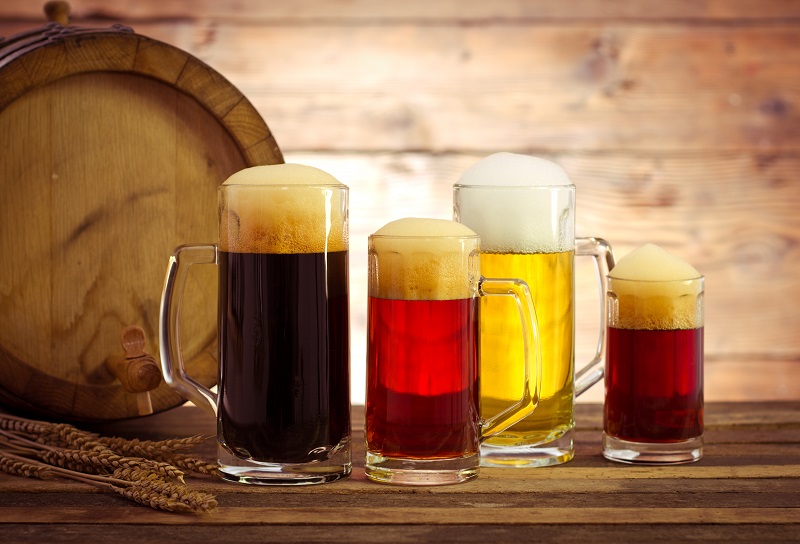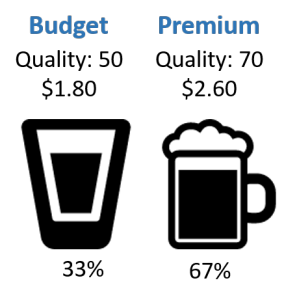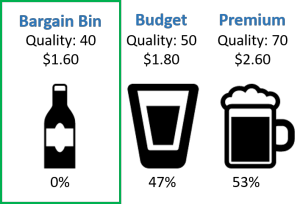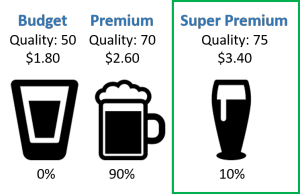… or why college kids have no clue about the price of beer

Here is one of the simplest pricing strategies you can use to increase your revenues. In a paper published in the Journal of Consumer Research in 1983, Duke University’s Joel Huber and Christopher Puto described a pricing strategy experiment that they conducted with 120 undergraduate students.
Pricing Strategy – Scenario One

The students were asked to make choices within several different product categories including restaurants, calculator batteries, cars, and beer. In the beer category, students were divided into three groups. The first group was asked to choose among two products. A budget beer that cost $1.80, which was rated 50/100 on a quality scale, or a premium beer that was priced at $2.60 and was rated 70/100 on the quality scale. When faced with this choice, 67% of the students chose the premium beer.
Pricing Strategy – Scenario Two

No one chose the bargain bin suds.
A second group was asked the same question, but now with a twist. Added to the core offer of the budget and premium beers a third option was introduced, a bargain bin beer that was priced at $1.60 and was rated 40/100 on a quality scale. When the students were offered this additional option it affected the overall purchase dynamics with 47% opting for the budget beer, and 53% choosing the premium beer. No one chose the bargain bin suds.
Pricing Strategy – Scenario Three

One final trial was done with the third group of students. Still offering the core options of the budget and premium beers, the researchers now added a super premium lager priced at $3.40 and with a quality rating of 75/100. When this option was offered, 10% chose the super premium beer, and 90% chose the premium beer. No one chose the budget brew.
Huber and Puto were seemingly able to manipulate the beer buying habits of thirsty undergrads by simply adding a third option on either the high or low end of the price/quality scale. If we were to quantify the magnitude of the disruption with a hypothetical 100 purchasers, it would go like this:
- Scenario One = 33x$1.80 + 67x$2.60 =$233.60
- Scenario Two = 47x$1.80 + 53x$2.60 = $222.40
- Scenario Three = 90x$2.60 +10x$3.40 = $268.00
But the really scary part is …
The difference between the best case scenario 3 and the worst case scenario 2 is 20.5%, which is a fantastic return for a simple tactic anyone can do! But the really scary part is that you could be accidentally depressing your revenues by not understanding the pricing psychology at play, and just like in scenario 2 be encouraging your customers to spend less.
Want to Implement this Pricing Strategy in Your Business?
Here are the 4 steps to implement this pricing strategy:
- Create a core offering for your product or service. (Focus these options on what is most demanded, and least resource intensive for you to deliver).
- Create a premium offer for your product or service. (Add all the luxury, high performance options).
- Create a low price, entry level offer for your product or service. (Keep this to the basic options).
- Experiment with combinations of displayed offers to see what pulls the best revenues overall. E.g.
- Entry
- Core
- Premium
- Entry + Core
- Core + Premium
- Entry + Core + Premium
- Entry + Premium
By doing these simple steps it will be a straightforward process to see what appeals most to your audience!
Want more? Read Steal Coke’s Pricing Strategy Based on Value Created Instead of Quantity Sold
Credit: Icons from www.flaticon.com is licensed by Creative Commons BY 3.0
![]()
